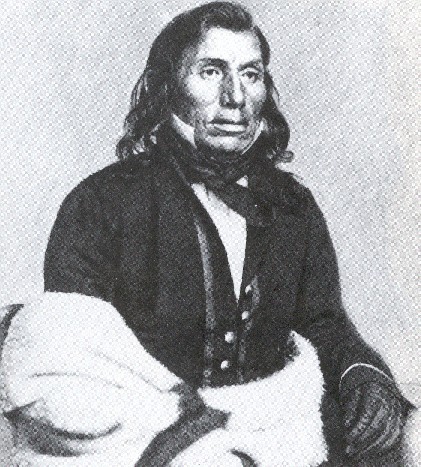Little Crow

Little Crow has gone down
in history as the leader of the Sioux Uprising of 1862. He was the 4th generation to
become Chief of the Sioux tribe. His name (before it was changed to Little
Crow) was Taoyatiduta. He signed with
Treaty of 1851 with that name, which means “his people are red.” Little Crow had six wives and 22 children,
seven of which were living at the time of the Massacre.
His inheritance to Chief was not exactly given with a lot of
honor. His father was injured by a
gunshot wound. His other son, Little
Crow’s brother, who would have been chief, died in battle with the
Chippewas. Little Crow’s father,
knowing he was going to die, told him he did not have any other choice than to
name him as the new Chief. He told his
son, “be honest…make yourself respected by the white people.” He also told him he had “very little good
sense”. With his father’s death, Little
Crow became the Chief of the band of Santee (Eastern Dakota).
As time went on, Little Crow became very unpopular among the
whites and Indians. This was mainly due
to the fact that he tried to lead the Indians and also listen to the
whites. Little Crow went to Washington
to meet with Buchanon about his people.
He dressed in white man’s clothing, joined an Episcopal Church, built a
house and started a farm.
However, with all his efforts, he still did not get
annuities promised by the whites.
Little Chief’s tribe began to become frustrated with him and
therefore elected Traveling Hail to take his spot. After the incident at the Jones’s farm, the Indians wanted his
advice. At first, still angry about
losing his authority, he told the men to ask their new chief. They assured him that he was still their war
chief. He listened to what the men had
to say, but was torn. He understood how
they wanted to attack before the whites attacked them, but he knew defeat would
be near impossible. He told the young
men this, and one brave called Little Crow a coward. Little Crow still wanted to restore honor and thought if he led
these men, he could get back his chieftanship.
Little Crow led the
Indians in the attack at Fort Ridgley.
Although he is known as the leader of the Sioux Uprising, there is a
strong belief among historians that he had nothing to do (didn’t take part)
with the attacks on New Ulm.
After the uprising, Little Crow and his people became Plains
Indians. He never wore white man’s
clothes again. He returned to Minnesota
to steal horses, which his people needed badly. While picking berries near Hutchinson, Nathon Lampson (some refer to him as Sampson), and his son Chauncy killed Little
Crow. Little Crow’s son Wowinapa,
stayed with him until he died and then ran away. By the time Little Crow’s body was brought back to Hutchinson,
his body had been badly mutilated and scalped.
Lampson received $500 for killing Little Crow. The scalp was donated to the Minnesota
Historical Society in 1868 by a janitor at the Capitol. His skull, which had been taken by Lt.
Farmer who found the body, was donated to the Historical Society in 1896. As the Society was in possession of some
other bones of Little Crow’s body, they returned them to his family in 1971 for
a proper burial. His grandson, Jesse
Wakeman (son of Wowinapa) said that Little Crow should be buried among his own
people.
Back HOME